Permet |
 Përmet
is located in the southeastern part of Albania. In ancient times it was
called Tryfilia, and it was inhabited by the Illyrian tribe of the
Parauej, who settled close to what is called today the Vjosa River. Përmet
is located in the southeastern part of Albania. In ancient times it was
called Tryfilia, and it was inhabited by the Illyrian tribe of the
Parauej, who settled close to what is called today the Vjosa River.
|
Historical
data show that since early times, Përmet had markets, shops, warehouses
and inns. This town is well-known for its hospitality, thrift, and its
tradition in the construction and decoration of houses.
Përmet is the place of origin of many reputable and historical figures, such as the Frasheri Brothers, the sculptors Odhise Paskali and Janaq Paco, the historians Stefanaq e Kristo Frasheri, the writer Nonda Bulku, Sejfulla Maleshova, the violin player Tedi Papavrami, the actor Naim Servet Frasheri and others. Among monuments of interest, it is worth mentioning the house of the Frasheri Brothers, the houses with typical architecture for the area, the Church of St. Mary in Kosine (12th century) and the bridge of Limari over the Zagori River. All these objects stand witness to the culture of this city. Përmet is known for its blacksmith tradition, silver works and the art of embroidery. It is also known for its metal, wood and stone products. The dances in this area are accompanied by an instrument called the saze, which is well-known both inside and outside the country. |
Translate
Wednesday, October 31, 2012
Albania - Permet
Albania - Tepelena
Tepelena |
 Tepelenë
was founded on the shores of Vjosa River, about 30 kilometers from
where this river meets the Drino, on a rocky elevation. The name
Tepelenë means “the Hill of Helen,” because according to legend, the
place had alliance agreements with the neighboring villages of Dames and
Dragot under the rule of Queen Helen. Tepelenë
was founded on the shores of Vjosa River, about 30 kilometers from
where this river meets the Drino, on a rocky elevation. The name
Tepelenë means “the Hill of Helen,” because according to legend, the
place had alliance agreements with the neighboring villages of Dames and
Dragot under the rule of Queen Helen.
|
Tepelenë
is the birthplace of Ali Pashë Tepelena. Although its fortress is not
as large and majestic as the castles of Berat, Shkoder and Gjirokastër,
it has a very special atmosphere, which many Anglo-Saxon visitors have
experienced and written about.
TepelenaAli Pasha is a very complex figure, who elevates the name of Tepelenë. He was the son of Veli and Hanko (the daughter of the Beg of Konice). His father died when he was 14. Through his bravery and his in-laws, he made a brilliant career. In 1784 he was awarded the title “Pasha” under the Veli of Rumelia. Through war he secured leadership of the Sanjak of Delvina, in the same year. In 1786-1788 he became the leader of the Sanjak of Thessalia and took over the governing of the Sanjak of Ioannina, defending the interests of the new landowners and the commercial bourgeoisie. He turned Ioannina into the international commercial center of southern Rumelia. |
Albanopolis
Albanopolis |
 Albanopolis ( Zgërdhesh) Albanopolis ( Zgërdhesh)Albanopolis lies on the right hand side of the road that leads from Fushë Kruja to Kruja, near the village of Halil. |
Albanopolis ( Zgërdhesh)
Albanopolis lies on the right hand side of the road that leads from Fushë Kruja to Kruja, near the village of Halil. In 1871, the renowned Austrian Albanologist, Hahn, visited the Illyrian Castle at Zgërdhesh and was the first to launch the idea that this was the ancient ALBANOPOLIS, the major settlement of the Alban tribe which gave its name to the whole country. The ancient town built on top of a hill occupied an area of 10 hectares. Powerful walls, 1,400 meters long, protected the town on all sides. Today only a 90 meter long fragment of the wall remains. The acropolis occupied a third of the area. Among the terracotta archaeological finds retrieved in Zgërdhesh, worthy of mention is a small marble statuette of the Goddess Artemis. The ancient town flourished for three or four centuries, until it was abandoned in the 2nd century A.D. The Illyrian city of Zgerdhesh is not mentioned in ancient literary or historical documents, as such, although many scholars believe that it was the city of ALBANOPOLIS mentioned by Pliny. Archeological investigations have shown that settlements on the site at the base of the Kruje end of the mountain range began in the 7C or 6C BC, when an acropolis covering about 1.3 hectares was enclosed with walls. In a second construction phase, in the 4C or 3C BC, a much larger area was enclosed, covering over 8 hectares, with the walls totalling 1350m in length. A series of defensive towers was built around the perimeter at this stage. The city seems to have flourished for 300 or 400 years before being largely abandoned in the 2C BC, and the inhabitants moved to Dyrrachium or Lissus. Some evidence of settlement has been found going up to the 6C, when Kruje came to dominate completely the surrounding district. A visit to Ancient Zgerdhesh is rewarding for the magnificent views across the coastal lowlands towards the Adriatic as well as for the impressive remains of Illyrian walls and fortifications. On a clear day there is a good view of the sea. Approaching from the lower part of the hill, you first see the massive foundations and walls of three rectangular Illyrian watchtowers, which are thought to have been built in the 4C BC. A protective earth bank appears to have been thrown up outside them, to assist the perimeter defenders of the fort. Follow the path up the hill on the right-hand bank of the small stream, past a military camp and conscript training center. On the path about 500m past the closed entrance track, at the base of the fort, there is an outstanding fossil bed, where in blue Lias (a type of limestone) many good quality fossils can be seen and collected. Ancient mussels are particularily common. Behind the watchtowers are two defensive walls, with earth packed in between them. These outer defenses run around the acropolis, at the lower end about 300m from the summit. Climbing the slope, you pass across what was the lower part of the town, with the foundations of various buildings of unknown use being visible, then up the slope towards the inner protective wall of the acropolis itself. On the left is a strong round tower and the inner wall, with an entrance through what would have been an inner gatehouse. This wall is about 150m long and has three defensive towers on the exterior at 50m intervals. Just inside the entrance are the foundations of an early Christian chapel, a very small building indicating the continued occupation of the site in later antiquity, but also its greatly diminished importance. The original city was built on the acropolis but there is little to see in the way of visible remains except a section of the eastern defensive wall, with a tower on the northeast corner. But, it is a beautiful place, with many birds and butterflies and wild flowers to be found, and somewhere suitable to reflect on the world of the ancient Illyrians and what many visitors to Albania find is the essential mystery surrounding the original inhabitants of the territory. DIRECTIONS FOR GETTING TO ANCIENT ZGERDHESH: Take the road directly east from Fushe Kruje, past houses and a small industrial district. Follow this road about 4km into the countryside, until a small track leading to the right of this road is met. It is possible to drive about 1km along this track before it is essential to walk towards the site. It is possible to walk back to Kruje, which takes about an hour and a half, along sheep tracks. |
Albania - vlora
Vlora |
 The
town has a rich history. In antique times, it was known by the name of
Aulona, which was given to it by early Hellenic settlers. In the Middle
Ages the Vlora region became an object of contention between various
international powers that wanted to maintain a hold on Albania. The
town has a rich history. In antique times, it was known by the name of
Aulona, which was given to it by early Hellenic settlers. In the Middle
Ages the Vlora region became an object of contention between various
international powers that wanted to maintain a hold on Albania. |
Vlora is a coastal
city. Vlora is not only the second major port, but also a centre of
great historical importance. In ancient times the city was known under
the name of Aulon. It was her that in 1912, the Assembly was convened to
proclaim Albania as an independent state, forming the first National
government headed by Ismail Qemali on 28th of November 1912. At this
time Vlora became the capital of the country until 1914. You
can drive south from Vlora, following the scenic route leading to
Saranda and discover the unspoilt beaches, the Bay of Portopalermo and
the traditional villages of Dhermi, Himara and Piqeras, to mention just a
few, with their cobbled streets, stone houses and courtyards shaded by
old vines. You
can drive south from Vlora, following the scenic route leading to
Saranda and discover the unspoilt beaches, the Bay of Portopalermo and
the traditional villages of Dhermi, Himara and Piqeras, to mention just a
few, with their cobbled streets, stone houses and courtyards shaded by
old vines.Vlora is the second major port of the country after Durrës. The city is situated in the South-western part of the country, in a picturesque area along the sea coast. Opposite the town lie the Karaburun Peninsula and the Sazan Island. Vlora has regular maritime connections with the Italian port of Brindisi and seasonal connections with that of Bari. The town has a rich history. In antique times, it was known by the name of Aulona, which was given to it by early Hellenic settlers. In the Middle Ages the Vlora region became an object of contention between various international powers that wanted to maintain a hold on Albania. During the Ottoman invasion it represented a centre of that power. This is also evidenced by the extensive Ottoman buildings in the city, such as the Great Mosque in the town centre, built in 1542 by the famous Turkish architect Mimar Sinan. A significant moment in the history of Vlora is the Declaration of Independence prior to the First World War, on 28th November 1912, by Ismail Qemali, a local bey. The event marked the end of five hundred years of Ottoman rule in Albania. The building that was the seat of the first government of an independent Albania is today a place of great interest for tourists. In the centre of town one's attention is drawn by the Monument of Independence, erected in Sheshi i Flamurit (The Square of the Flag).  Another
very interesting religious location is also "Kuz Baba" building of the
Bektashi sect, perched up on the hill towering upon the town centre.
This spot offers a unique view not only of the town, but also of the
entire Vlora Bay. Another
very interesting religious location is also "Kuz Baba" building of the
Bektashi sect, perched up on the hill towering upon the town centre.
This spot offers a unique view not only of the town, but also of the
entire Vlora Bay. |
Albania - Durres
Durres |
 It
is the second largest city of Albania in terms of size, but also the
largest most important port in the country. Durrës is one of the oldest
towns in Albania with a long and turbulent history. According to ancient
sources Durrës was founded in year 627 B.C by colonists from Corcyra
and Corinth and settled in the territories of the Illyrian tribe of
Taulantii. Initially, it was known by the name of Epidamnus, while
later, by the name of Dyrrhachium. It
is the second largest city of Albania in terms of size, but also the
largest most important port in the country. Durrës is one of the oldest
towns in Albania with a long and turbulent history. According to ancient
sources Durrës was founded in year 627 B.C by colonists from Corcyra
and Corinth and settled in the territories of the Illyrian tribe of
Taulantii. Initially, it was known by the name of Epidamnus, while
later, by the name of Dyrrhachium. |
 Durres
is one of the biggest towns and seaports in Albania. It has a
population of 95.400 inhabitants. Durres is 39km from Tirana (capital of
Albania). Durres is one of the most ancient cities in the country. It
was founded by Epidamnos, the Illyrian King of the area, who called it
by his own name and named the port area after his grandson- Dyrrah. From
1914-1920, Durres became the capital of Albania. Only 5 km away from
Durres town is the beach area of Durres. Durres
is one of the biggest towns and seaports in Albania. It has a
population of 95.400 inhabitants. Durres is 39km from Tirana (capital of
Albania). Durres is one of the most ancient cities in the country. It
was founded by Epidamnos, the Illyrian King of the area, who called it
by his own name and named the port area after his grandson- Dyrrah. From
1914-1920, Durres became the capital of Albania. Only 5 km away from
Durres town is the beach area of Durres.Of great interest to visit are: The fortress of the city, the Amphitheater, Roman Thermal Baths, Archeological museum. It is the second largest city of Albania in terms of size, but also the largest most important port in the country. Durrës is one of the oldest towns in Albania with a long and turbulent history. According to ancient sources Durrës was founded in year 627 B.C by colonists from Corcyra and Corinth and settled in the territories of the Illyrian tribe of Taulantii. Initially, it was known by the name of Epidamnus, while later, by the name of Dyrrhachium. Later Durrës became the seat of the Illyrian kings of Taulantii, first, King Glaukias, and later, his sons, Monounios and Mytiles. In 314 B.C. the city was occupied by the Cassander of Macedonia, while in 229 B.C. it was conquered by the Romans. During the Roman rule, the amphitheater, the aqueduct, and other objects were built there.  Mbreteresha
Teuta DurresDuring the 7th to the 12th centuries, Durrës developed into
the most important port of eastern Adriatic. In 1368, the city fell
under the influence of Albanian prince Karl Topia, who in 1386, was
forced to surrender the city to Venice. The latter held the city under
its domination for 108 years. In 1501, Durrës was captured by the
Ottomans. After that, the city began to decline and lost its importance.
On the eve of independence, Durrës was occupied by the Serbs, who fled
from it in May 1913. Unfortunately, during their withdrawal, the Serb
forces plundered many rare archaeological exhibits which today are
displayed in the Belgrade museums. Mbreteresha
Teuta DurresDuring the 7th to the 12th centuries, Durrës developed into
the most important port of eastern Adriatic. In 1368, the city fell
under the influence of Albanian prince Karl Topia, who in 1386, was
forced to surrender the city to Venice. The latter held the city under
its domination for 108 years. In 1501, Durrës was captured by the
Ottomans. After that, the city began to decline and lost its importance.
On the eve of independence, Durrës was occupied by the Serbs, who fled
from it in May 1913. Unfortunately, during their withdrawal, the Serb
forces plundered many rare archaeological exhibits which today are
displayed in the Belgrade museums.Today the city of Durrës is the largest and most popular holiday resort in the country. It is a sandy and shallow beach, which makes it a favorite beach for families and their children. The city hosts very important sites, favorable for cultural tourism, such as the Amphitheater, the Byzantine forum, the archaeological museum which displays the Greek and Roman periods, the Venetian tower, the Fatih mosque, the Monument of Resistance, which is dedicated to the armed struggle against the fascist occupation of the country by fascist Italy on 7 April 1939, the Ethnographic museum. Through its harbor, the city has regular links with ferryboats to the Italian ports of Bari, Ancona, and Trieste. Durrës Beach  Plazhi
i Durresit 2Perhaps the most famous Albanian beach, it lies to the
south of the town of Durrës, only 39 km away from the capital. This is
the most popular beach in the country. It is 6 km long and the sand belt
is wide. The waters are quite shallow close to the shore, which makes
the beach very suitable for families and children. Its position in
Durrës Bay protects it from winds. Durrës Beach has the largest
concentration of tourist facilities, such as hotels, motels, villa
compounds, bars, restaurants, nightclubs, bowling alleys, fitness halls
and gyms, game parlors, etc. In addition to day tourists from the
capital, Durrës beach is the number one destination for tourists from
Kosova and Macedonia. Plazhi
i Durresit 2Perhaps the most famous Albanian beach, it lies to the
south of the town of Durrës, only 39 km away from the capital. This is
the most popular beach in the country. It is 6 km long and the sand belt
is wide. The waters are quite shallow close to the shore, which makes
the beach very suitable for families and children. Its position in
Durrës Bay protects it from winds. Durrës Beach has the largest
concentration of tourist facilities, such as hotels, motels, villa
compounds, bars, restaurants, nightclubs, bowling alleys, fitness halls
and gyms, game parlors, etc. In addition to day tourists from the
capital, Durrës beach is the number one destination for tourists from
Kosova and Macedonia.To the north of Durrës, at the foot of the hills, is the well-known Plazhi i Currilave, where the waters are deep and the rocky beach is well protected from the hot winds coming from the land. Activities: sun and sea tourism, rowing, motorboat tours, water sports, etc |
Albania - gjirokaster
Gjirokaster
 Gjirokastra
is one of the most attractive towns of Albania. Gjirokastra has been
called the City of One thousand Steps or The Stone City. Gjirokastra
is one of the most attractive towns of Albania. Gjirokastra has been
called the City of One thousand Steps or The Stone City.
|
| Gjirokastra is one of
the most attractive towns of Albania. Gjirokastra has been called the
“City of One thousand Steps” or “The Stone City”. It is of particular interest for its native architecture. The characteristic houses clustered around the majestic fortress towering above them as a huge battle ship, are small fortresses in themselves. Sheltered by a castle, the ancient city of Gjirokastra, with its mysterious atmosphere, is set against the dramatic backdrop of the mountains.  The
narrow, winding cobbled streets of “the Museum City” of Gjirokastra
exude a distinctive medieval feel. The castle is one of the best places
where you have also the possibility to see the whole town. While in the
area, why not spend the night in one of the typical houses. The
narrow, winding cobbled streets of “the Museum City” of Gjirokastra
exude a distinctive medieval feel. The castle is one of the best places
where you have also the possibility to see the whole town. While in the
area, why not spend the night in one of the typical houses.Gjirokastër was declared a “Museum City” in 1961 and a “World Heritage Site” by UNESCO in 2005. It is the main southern city in the country. Initially, it was an Illyrian settlement linked to the Argjiro tribe. According to legend, Gjirokastër was founded by Princess Argjiro. In the Byzantine Chronicles of John Kantakuzen, Gjirokastër is mentioned as the fortress of the Zenebish family. In 1417 the Turks conquered it and turned it into an important center of Ottoman power and administration for hundreds of years. Gjirokastër became the center of the Sanjak of southern Albania. Visitors are impressed by the architecture of the city, the surprising landscape of the Drino Valley, and the invincible lime peaks of the Bureto and Lunxheri mountain chains. Whoever visits Gjirokastër understands Albania’s character –a beautiful and tough place with an uncompromising spirit. Situated in a particularly sensitive area of strategic and military importance, and with a very close proximity to the Greek border, Gjirokastër has been the stage of many important events in the history of the country. One of the most important: this is the birth place of the writer Ismail Kadare Ismail Kadare  The
renowned Albanian writer, Ismail Kadare, was born in Gjirokastër in
1936. He studied literature at the University of Tirana and later
continued his studies at Gorky University in Moscow.He returned to the
country in 1961, after relations between Albania and the Soviet Union
were severed. He started working as a journalist and became famous with
his first novel, “The General of the Dead Army” (Gjenerali i ushtrise se
vdekur), which he wrote between 1962 and 1966. The
renowned Albanian writer, Ismail Kadare, was born in Gjirokastër in
1936. He studied literature at the University of Tirana and later
continued his studies at Gorky University in Moscow.He returned to the
country in 1961, after relations between Albania and the Soviet Union
were severed. He started working as a journalist and became famous with
his first novel, “The General of the Dead Army” (Gjenerali i ushtrise se
vdekur), which he wrote between 1962 and 1966.Later, this novel served as the script for the movie with the same title, which starred the well-known Italian actor, Marcello Mastroianni. Kadare’s career was a success inside and outside the country. Today, he is the icon of the Albanian literature and also the most translated and the most successful writer outside the country. He has been a candidate for the Noble Prize in literature several times, and has been crowned with many honorary prizes of the world literature. He was awarded the first “Man Booker International Prize in 2005.” |
Albania - Berat
Berat
 Berat
is known as the “City of One-Thousands windows” due to the
characteristic architecture of its houses. The city was originally
Illyrian, as one can see from the great blocks of stone at the base of
the fortress walls. Berat
is known as the “City of One-Thousands windows” due to the
characteristic architecture of its houses. The city was originally
Illyrian, as one can see from the great blocks of stone at the base of
the fortress walls. |
Berat is known as the
“City of One-Thousands windows” due to the characteristic architecture
of its houses. The city was originally Illyrian, as one can see from the
great blocks of stone at the base of the fortress walls. As an ancient
Illyrian settlement founded in the 4th and 5th centuries B.C. on the
territory of the Illyrian tribe of Desarettes, Berat was transformed at
the beginning of the 3rd century AD into fortified city known by the
name of Antipatrea. Berat is a “Museum City” built on the slopes of a
mountain with a castle dominating the site.  The
castle is of great interest. Within its walls, there is a residential
quarter consisting of a considerable number of characteristic houses,
cobblestone roads, and several churches belonging to different
historical periods. The most interesting are the church of Saint Mary
Vllaherna (13th century), the church of Saint Trinity, which is one of
the most outstanding examples of Byzantine architecture in Albania. The
Cathedral of Saint Mary was rebuilding in 1797 on the ruins of a
previous church. Berat was occupied by the Ottomans and several mosques
were constructed just below the castle, such as the King’s Mosque and
Leaden Mosque. The “Onufri Museum” is well worth visiting for its
paintings and icons created by Onufri, the remarkable 16th century
painter, and the works of other artists. The
castle is of great interest. Within its walls, there is a residential
quarter consisting of a considerable number of characteristic houses,
cobblestone roads, and several churches belonging to different
historical periods. The most interesting are the church of Saint Mary
Vllaherna (13th century), the church of Saint Trinity, which is one of
the most outstanding examples of Byzantine architecture in Albania. The
Cathedral of Saint Mary was rebuilding in 1797 on the ruins of a
previous church. Berat was occupied by the Ottomans and several mosques
were constructed just below the castle, such as the King’s Mosque and
Leaden Mosque. The “Onufri Museum” is well worth visiting for its
paintings and icons created by Onufri, the remarkable 16th century
painter, and the works of other artists.The town is composed of three parts: Gorica, Mangalem and the residential quarter within the fortress known as Kalaja. The city of Berat lies on the shores of the Osum River. With its well-preserved Ottoman architecture, the city boasts a wealth of buildings of exceptional historical and architectural interest. In 1961 it was declared a Museum City of Albania and is anticipated to be named a UNESCO World Heritage City in 2007 or 2008. Berat has been inhabited since prehistoric times and its extraordinary value relates to this 2400-year existence. A number of interesting sites of both cultural and natural significance are to be found here, which makes it one of the most complete tourism destinations in Albania, attracting many tourists throughout the entire year.  Cultural
attractions in Berat include the castle, the ethnographic museum, the
Onufri Museum, and the historic Medieval Center, where the current
offices of the Institute of Cultural Monuments can be located. Cultural
attractions in Berat include the castle, the ethnographic museum, the
Onufri Museum, and the historic Medieval Center, where the current
offices of the Institute of Cultural Monuments can be located.The historic districts of Mangalem and Gorica are not to be missed, either. Other cultural activities in the city of Berat include taking an evening promenade along the Osum River and visiting the local artisans and Edward Lear Art Gallery. Natural attractions include the Osum River, where one can fish and canoe, and Tomorr Mountain, a refreshing refuge from the city where “chai mali” (mountain tea) can be picked in the late spring through the early fall. |
Albania - Tirana
Tirana |
 Tirana
is the capital of Albania and also the most important political,
economic and cultural centre of the country. It is located in a very
favorable position, right in the centre of the country, at an altitude
of 113 meters above the sea level. Tirana
is the capital of Albania and also the most important political,
economic and cultural centre of the country. It is located in a very
favorable position, right in the centre of the country, at an altitude
of 113 meters above the sea level.
|
 Tirana
is the capital of the Republic of Albania, with a population of just
over 700.000, lies at the foot of “Dajti” mountain (1612m) at 110 m
above the sea level. The region of Tirana has been inhabited since the
Neolithic period. Tirana was founded in 1614. The construction of Ethem
Bey’s Mosque, situated at the present day Scanderbeg square, began in
1789. Tirana was proclaimed capital of Albania in 1920. The population
of Tirana had 17.000 inhabitants at that time. Tirana
is the capital of the Republic of Albania, with a population of just
over 700.000, lies at the foot of “Dajti” mountain (1612m) at 110 m
above the sea level. The region of Tirana has been inhabited since the
Neolithic period. Tirana was founded in 1614. The construction of Ethem
Bey’s Mosque, situated at the present day Scanderbeg square, began in
1789. Tirana was proclaimed capital of Albania in 1920. The population
of Tirana had 17.000 inhabitants at that time.It is the most important political, economic, educational and cultural center of the country. Tirana is the capital of Albania and also the most important political, economic and cultural centre of the country. It is located in a very favorable position, right in the centre of the country, at an altitude of 113 meters above the sea level. To the west, the Adriatic Sea and the largest and most popular beach in Albania, the Durrës beach, are only 32 km away, while to the East, the Dajti Mountain, 1612 m high, is only 26 km away. Tirana is a relatively young city. It was founded in 1614 by Suleyman Pasha Bargjini, a local feudal lord who built the first buildings that formed the nucleus of the new town: a mosque, a hammam, and a bakery, at the place where today is the monument of the Unknown Partisan (Partizani i Panjohur). In 1816, the town was ruled by the Toptani family. The most important date in the history of Tirana is 11 February 1920, when the Congress of Lushnja proclaimed it the provisional capital of Albania, which was changed into a full status in 1925.  After
this decision the city has known constant growth, which reached
unprecedented rates in the 1990s. The Tirana downtown was designed by
well-known Italian architects of the Mussolini period. The Big Tirana
Boulevard "Dëshmorët e Kombit" (Martyrs to the Nation) was built in
1930, while the main square in the centre, Skanderbeg Square, was built
during 1928-1929. After
this decision the city has known constant growth, which reached
unprecedented rates in the 1990s. The Tirana downtown was designed by
well-known Italian architects of the Mussolini period. The Big Tirana
Boulevard "Dëshmorët e Kombit" (Martyrs to the Nation) was built in
1930, while the main square in the centre, Skanderbeg Square, was built
during 1928-1929.In commemoration of the 500th anniversary of the death of the Albanian National Hero, Skanderbeg, an equestrian monument was placed there in his honour. In 1988, a monument of the former communist dictator was also placed in the square, but it was toppled on 20 February 1991, by students and the people of Tirana. Important buildings in Tirana include the Palace of Congresses, the International Centre of Culture, the Palace of Culture and the Theatre of Opera and Ballet, the Sky Tower etc., as well as government buildings of the Council of Ministers, Presidency and Parliament. In addition to the Great Park in the southern part of the city, Tirana has other parks such as Rinia (Youth Park), the Parliament Park, the park close to the Presidency building, etc. Tirana is a major convention, conference and seminar centre in Albania. Also, owing to its young and student population, Tirana has an attractive night life offering a variety of restaurants, cuisines, bars, pubs and night clubs to visitors and locals alike. |
Albania....friendly Albania....beautiful Albania
Albania....friendly Albania....beautiful Albania
 I woke very early (I'll have a word with that cockerel later) in a
seemingly utopic, very rural, very isolated verdant mountain valley.
For a brief moment the steep, jagged mountains carpeted in dense, green
woodland that towered impressively all around echoed with just the sound
of silence. I was of course still half asleep, the family of the
farmstead where I was staying were already busy (things start very early
in Albania) in the kitchen preparing breakfast, their sheep were
wandering around doing "sheep stuff", the turquoise coloured mountain
river thundered in the distance and smoke was rising willowy from the
chimneys of the couple of other wooden roofed houses that call this
unspoiled valley home. And, there was the sound of my still happily
snoozing, fellow intrepid trekkers.
I woke very early (I'll have a word with that cockerel later) in a
seemingly utopic, very rural, very isolated verdant mountain valley.
For a brief moment the steep, jagged mountains carpeted in dense, green
woodland that towered impressively all around echoed with just the sound
of silence. I was of course still half asleep, the family of the
farmstead where I was staying were already busy (things start very early
in Albania) in the kitchen preparing breakfast, their sheep were
wandering around doing "sheep stuff", the turquoise coloured mountain
river thundered in the distance and smoke was rising willowy from the
chimneys of the couple of other wooden roofed houses that call this
unspoiled valley home. And, there was the sound of my still happily
snoozing, fellow intrepid trekkers.Wandering around the lovingly planted fields of the farmstead, with it's rustic outbuildings I looked back to soak up this scene of bucolic, mountainous nirvana. Just a handful of scattered traditional farmstead homes occupy the valley floor, out of which rise sharply The Accursed Mountains of northern Albania, a sight I'd be wishing to see for many years. I was here at last, and everything seemed just perfect. This was definitely a "glad to be alive" day.
Seeing me wandering around, the owner of the farmstead (Deda our host) came out to greet me with a bottle of his Raki, a rather potent home-brewed (and home grown for that matter) clear brandy. It is the Albanian way to start the day with a shot of Raki (they say it's good for the digestive system for one!), so "when in Rome?" I thought to myself reinforced with the lame excuse that it would rude to refuse. Toasting each other's health thus the day began and I have to admit I felt more than a bit smug being able to enjoy a bit of the famed Albanian Highlander hospitality and friendliness I'd read so much about all by myself.
I felt like I'd been here in Nderlysa a lifetime, but in fact our group of trekkers had arrived just the night before after trekking through the Boga Valley, then up and over the Diagonal Pass to then descend sharply through forest into the delightful Kaprea Valley below.
It's the beginning of June 2010 and I'm here in the far north of Albania with a handful of adventurous trekkers on Walks Worldwide's "research and reconnaissance" trek into the Accursed Mountains that border Montenegro. We're not the first group of trekkers here by a long shot, but the locals tell us wherever we go that this is the first time they've encountered a commercial trekking group coming to the north with a UK Trekking Operator. Whether that's true or not I couldn't say. Although throughout the entire trip we didn't actually encounter a single other person trekking on the trails we followed, and could count on one hand the number of "foreigners" we actually met during our time in Albania. Of course people come here trekking. If they didn't there'd be nowhere to stay for one! But, not many come here that's for sure compared to other places in Europe and the rest of the world for that matter. For me trekking is naturally a pleasure and something I've been doing around the world for over 30 years, but it's also my business too and amongst my "Trekking Industry" mates, not a single one had been trekking in Albania, and as we do like to score "brownie points" against one another by going to places the others haven't, Albania is currently mine and Walks Worldwide's "brownie point".
Back to Albania. What a wonderful country, and what fantastically friendly and welcoming people. It's a country of contrasts from the ultra-modern, chic bars and cafes of the capital Tirana, to the isolated, remote, rural north where life (in spite of my depiction of a rural idyll) remains hard, especially in winter. However, it is the determined, stoic, hard-working nature and character of the people of the north that makes them such a pleasure to meet.
Throughout our trek in the Accursed Mountains we had to constantly keep reminding ourselves that we were in fact in Europe. Life for the local people we found to be similar to life in remote Himalayan villages for example. Our new friends, the family in Nderlysa being a good example. Our host, Deda, the father of the family runs a small farmstead. Self-sufficiency is an absolute necessity to survive. The family keep around 40 sheep, a few cows and grow all the seasonal vegetables they need. They have electricity from a local hydro-powered source and the freshest, mountain purified spring water you could wish for. For them their nearest shop is almost 5 hours drive away, and it's not a straightforward 5 hours at that either. They must either walk out the way we walked in or drive a perilous, appallingly bombed out, single track, rocky mountain road to connect with the outside world. It's the only way in and out really and until this improves it certainly also keeps all but the most intrepid of tourists away too. During the snows of winter the inhabitants of the valley are effectively cut-off and from October to early May the younger children of Deda's family go and live with relatives in the northern city of Shkodra. For those adventurous tourists that do venture into the Accursed Mountains, until things change there remains a place that is a seriously special, preserved part of Europe. In fact life is so tough here that many of the families that live in the valleys of the Accursed Mountains have either left for good, or return only in the summer months.
Deda and a few other farmstead owners in Thethi Valley however realised that the right sort of tourism would be a good way of preserving the traditional way of life for the valleys, as well as providing a great experience for their visitors too and converted parts of their farmstead to provide accommodation. With the aid of grants Deda has created two western European style bathrooms, with showers, sit-down toilets, wash basins and hot water, as well as simple bedrooms for visitors to sleep in. One can only imagine the sight of beds, tiles, toilets, plumbing materials etc coming over that dodgy mountain road!
For us as visitors it was both a privilege and a genuine travel experience to stay in farmsteads like Deda's along the way. Virtually everything we ate was grown or raised on the farmstead, and prepared by the family in their small kitchen. We certainly ate well and hearty! Absolutely delicious sheep cheese, home-made and freshly baked bread, vegetables straight from the garden that tasted like vegetables should, succulent meats, chunky soups and copious amounts of Turkish style coffee and fragrant "Chai", a tea-like brew made from the herbs that grow on the mountain slopes.
The Accursed Mountains themselves are truly spectacular. Seemingly impenetrable, jagged karstic peaks, broody and looking more like they are 4000m high than 2500m, as they rise so abruptly and sharply from the low valley floors. Trekking amongst these hostile looking mountains is quite challenging, steep ascents to passes, but efforts usually rewarded with incredible panoramic views, along with that self-satisfaction of knowing that you're trekking off the beaten track and have these incredible mountains and valleys almost to yourself and you feel like you've earned the right to be here. The Accursed Mountains are the realm of the committed mountain trekker and most certainly not for those that seek leisurely walks. Neither is this a place for those that feel the need to be ensconced within some sort of artificial tourist bubble either. This is the Accursed Mountains, it's real and it's alive. You live it and you feel it as it really is. Anyone who cannot cope without western European life will hate it. As our guide Florian told us, Albania would be at the top of the list for friendliness and hospitality, but at the bottom for infrastructure. I would add to that, that the north of Albania and especially the Accursed Mountains would also be at the top for scenery too.
Perhaps it is this that makes Albania special. Europe's secret place for real adventure travel. Even in Tirana there isn't a McDonalds yet.
I'll certainly be going back to Albania to explore further for my own holidays time and again now. Although I dearly love being in countries such as Nepal and India, like many I don't have the time (or the money!) to go to these long-haul exotic sounding places that often nowadays. So, it was great to discover somewhere "exotic" closer to home that can provide such genuine and very, very different cultural and travel experiences, where you really feel like an intrepid traveller and not just another run of the mill tourist.
Albania is of course changing fast in it's towns and cities, but I suspect it will be sometime yet before The Accursed Mountains of the far north become unrecognisable from what our first ever trekking group experienced and when and if it changes, that is of course up to the locals to determine anyway.
All the same, even modernised Albania remains delightfully Albanian as we found at the virtually brand new terminal building of the one and only International Airport for our departure. After checking in for our flight home we could tell from the computerised arrivals board that our flight would be delayed as the incoming plane was clearly well behind schedule. The computerised departures board showed our flight to be departing on time. The "Duty Free" shop was of course closed and as our scheduled departure time grew nearer the computerised departures board told us it was time to start boarding a plane that had still not yet arrived.
In brief....Albania rocks!
Sarande, Albania: Beautiful Beaches, Mountains and Seafood
Sarande, Albania: Beautiful Beaches, Mountains and Seafood
Why Go
The afternoon was fading as I wandered through the tired alleyway
s of Corfu town, and restless in a
I looked out across the gentle Mediterranean sea to a country that I knew would make me feel alive. Albania.
The next morning I prepared to get on the hydrofoil to the town of Sarandë (also known as Saranda), half an hour away. Concrete high rises stomped round the bay like an amphitheater, half of them unadorned with windows or paint. The throbbing town beach was made up of equal parts shingle and cigarette ends. The roads were pock-marked and power cuts were frequent. Yet somehow Sarande feels fresh.
The town follows the curve of the emerald sea, which brings a cool breeze through the palm trees that line the promenade, to the streets that step up the hills and buzz with Internet cafes and arcade rooms. And what Sarande lacks in physical charm, it makes up for with its hospitable people.
When the sun sets over the bay, thousands descend on the prom by the beach. Old men in brown slacks watch life slowly pass as they perch on the sea wall, next to young guys checking out the glamorous girls. Tavernas heave with holiday-makers enjoying fresh seafood risotto, and snake charmer sounds
languor through the streets from the rooftop bars, where young things dance to live Albanian music.
This town of 30,000 is a major domestic holiday destination, though you will barely see a foreigner. In fact the tourist office might be the saddest building in Sarande. A glass dome built on stilts out in the water, it surely looked futuristic in the early nineties, when it was built after the fall of the most paranoid dictator on the continent - Enver Hoxha. It now looks like a tired prop from Back to the Future. So get to Sarande before the world catches up with what Albanians already know: this town is the gateway to some of the most beautiful mountains, springs and beaches in Europe, as well as gorgeous Balkan towns such as Gjirokastër and the ancient city of Butrint.
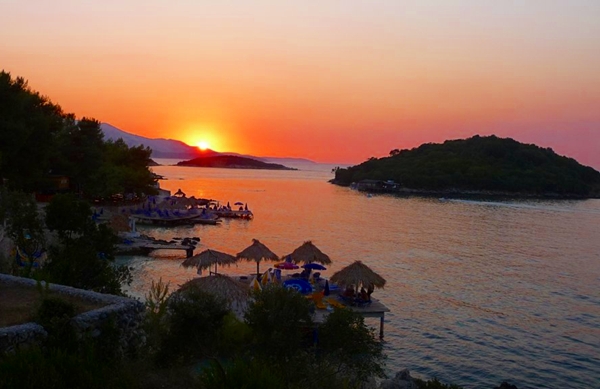
Ksamil Beach, near Sarande, Albania
Insider Tips
- There are flights to Tirana's Mother Teresa airport all year round,
from there it is possible to take a bus to Sarande. But the best time to
visit the Albanian coast
is in summer, with the pristine beaches surrounding Sarande are the perfect antidote to temperatures that can reach the forties.
- Easyjet flies from London Gatwick to Corfu Town from March to October. From there, the 9am hydrofoil leaves for Sarande from €38 return with Ionian Cruises Expect the skipper to hold onto your passport for the trip's duration.
- There is currently no visa fee for entering Albania at Sarande port customs.
- The Albanian currency is the Lek, and there are plenty of ATMs in
Sarande that take international cards. Outside the town gardens, dozens
of men openly
exchange Euros for Lek at a much better rate than Bureau de Change, although this practice is illegal. Make sure to spend your cash before you leave, Lek cannot be exchanged outside the country.
- What makes Albania great is its people, most of whom will go out of their way to help you. But you will find the odd person trying to rip you off, so be sure to check your change and pay what you think is a fair price for items.
Where to Stay
Backpackers SR Hostel is set in a modern apartment just off the town beach. A converted family home, on first entering the hostel dining room the mind flips to relief. Splashed across the wall are kind words from travelers, calling for the owner Tommy to become 'major of Sarande, no president of the world!' Then comes bewilderment, because in the corner lies an army helmet and grenade. The owner admits with a wink, 'They're from 1997, when the government pyramid schemes went bust. We all lost our life savings, so we all attacked the government. A bunch of us broke into some army barracks, and we took some, ahem, souvenirs.'
There is nowhere like Albania. There is no generosity like Albanian generosity. A tour guide who becomes a friend, Tommy becomes as much or as little a part of your stay as you wish. He is happy to meet you from the bus station or port and make you breakfast. He will offer to take you to exchange your money, and answer all those tiresome questions about Albanian politics and history with humor. His English is perfect, his knowledge of great restaurants, bars and beaches in the surrounding area unparalleled. Prices average €10 a night for a four-bed dorm.
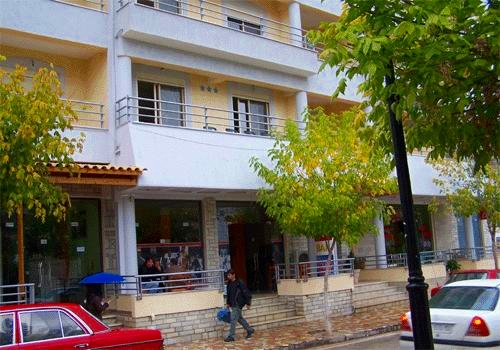
Backpackers SR, Sarande, Albania
Sarande may not offer boutique hotels or chic architectural design, but the town is nevertheless perfect for luxury stays on a budget. Reserving online is not possible for all but a few 3-4 star hotels such as Brilant Hotel (which is a nice choice if you want a room with a private veranda and sea views) so the best way to find a bargain stay is to simply rock up to town and ask around. You should be able to pick up a plush room with great views for €30 a night, compared to €120 across the strait in Greece for a similar pad. Try the brand new hotels first, they often offer the best rates.
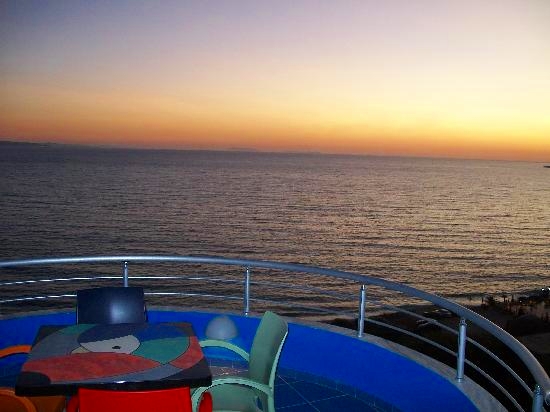
Private Veranda, Brilant Hotel, Sarande, Albania
What to Eat
Albanian food on the Rivera is typically Mediterranean fare, with seafood and feta salad mainstays on every taverna menu. But one of the region's best dishes is baked lamb's stomach on a bed of tomatoes and olives, which is cooked in olive oil until tender. After dinner knock back some Raki, the local firewater made from grapes mixed with herbs and honey. Also make sure to try fresh seafood, especially mussels. These come from Lake Butrint an hour away, and they are perfectly sweet and wonderfully salty at Paradise on the promenade.
The ancient farmer's market, set in a crumbling stone building across from the bus stop for Butrint, is otherworldly. Street food in Sarande is also great, with old popcorn machines and corn on the cob sellers lining the beach. Indulge in some cheese and bacon galettes at 9 Rruga Mithat Hoxha for 60 cents.

Seafood lunch in Sarande, Albania
What to See and Do
Most of the area's attractions are outside Sarande, but easy to get to. Archaeological site Butrint is the most famous destination on the Riviera, and the 'quietest, coolest, most pleasant place in the world' according to philosopher Cicero in 56 BC. Occupied by Greeks and Romans, Byzantines and Venetians, by 4 BC the city was a commercial center of the world. Sites like the grand amphitheater display the old city's prosperity.
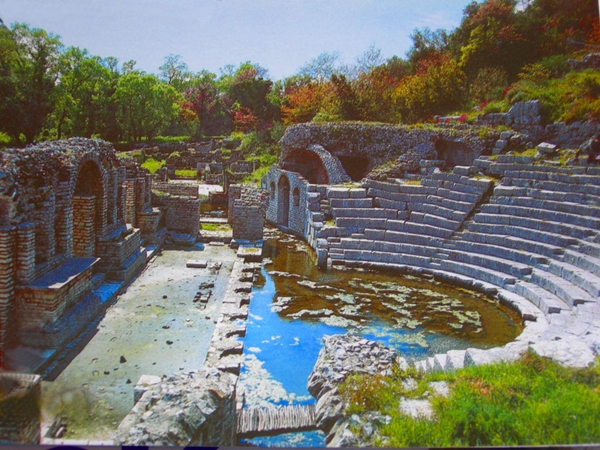
Butrint Amphitheater, Albania
But Butrint was abandoned in the late Middle Ages due to flooding. Its marshy past preserved the acropolis, fountains and baths and Butrint is now an idyllic national park with UNESCO status. The view by the castle at the top of the hill is beautiful. Butrint lake is peppered with mussel catchers, with grand hills following the lagoon to a plateau where distant castles are sprinkled across the fields. Marshes follow the Vivari canal out to sea, the water nudging against deserted beaches in great white wisps.
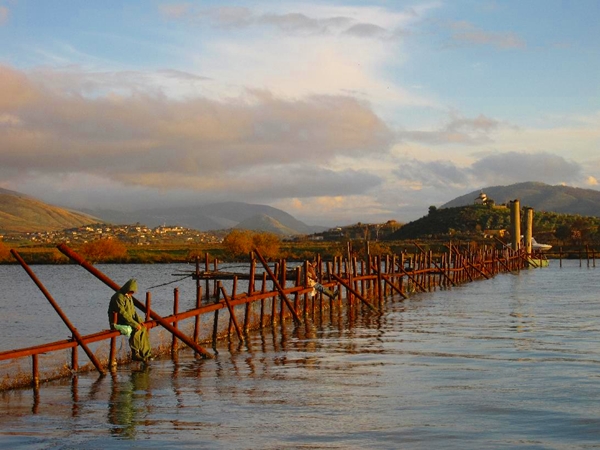
Fishing in Butrint, Albania
To take the bus to Butrint, turn left at the junction 100 meters down from port customs. Here you will see the bus stop. There are buses every hour during the morning (about €0.60 return). The archaeological site is only 14km away, but the journey will take an hour because the road is little more than rubble. Otherwise take a taxi to Butrint for about €2. Entrance costs about €5 for non-Albanians.
On the way back to Sarande, ask the bus driver to drop you off at Ksamil. The village is wrecked, many buildings lie face down on the ground. But these eyesores are not the result of earthquakes, but corruption. Some builders knowingly buy land from owners who are not really the owners, and another concrete carcass is hauled out from the ground without permission. Unless the builders have enough money to pay off the politicians, the government can come with a crane one day and pull the building down. Too expensive for developers to start again, the apartments are left collapsed, leaving areas of Albania decimated.
But despite its problems, Albania is a naturally beautiful country. Nowhere is this more true than in Ksamil, which means little islands. Rippled by the clear sea, one of the lush islands has a shack which serves grilled fish to the stronger swimmers who can make it over. The beach is also stunning and rarely too crowded, with the chatter of Albanian sunbathers as pleasant a sound as the Cicadas in the trees.
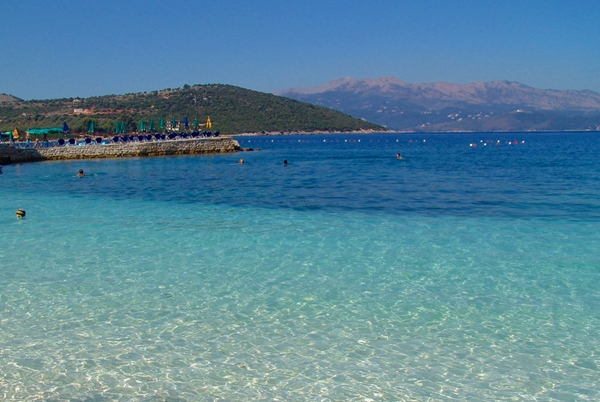
Ksamil Beach, near Sarande, Albania
The Blue Eye is a geographical phenomenon, an azure spring where visitors can throw a stone into the eye only to see it bubble back up to the surface. Shaded by woods, this is a pleasant spot for a picnic. Alternatively, there is a restaurant by the waterfall overlooking the springs. To get there, take a bus going to Gjirokastër from Sarande's bus depot - buses leave town all morning. Ask the driver to drop you off by the springs, which are slightly over an hour away. From the main road, it is about a mile walk to the Blue Eye. Others will be taking the same route in summer.
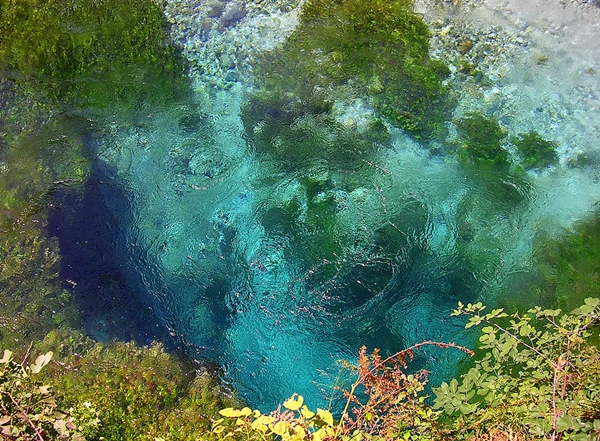
Blue Eye, Gjirokaster, Albania
Visit Hoxha's birthplace Gjirokastër. It is an old-world town of 40,000, centuries away from the brash buildings in Sarande and Ksamil. Nestled in the Drinos river valley, the Ottoman houses with unique stone roofs charmingly tumble down from the 13th century Citadel.
Wonderful Albanian Lakes
Wonderful Albanian Lakes
image hosted on flickr
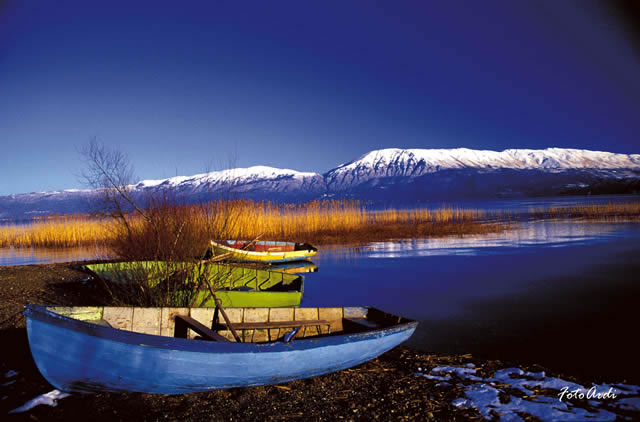
Albania has many different types of lakes. Its major lakes are Shkodra, Ohri, Lura and Prespa.
Shkodër Lake is the biggest lake in Albania and also in Balkan Peninsula. It has an area of 368 km.sq. Shkodra lake in the Albanian territory is characterized by the diversity of shores and the land .The eastern shores are low with marshes while the southern shores are high and with rockies. The water of lake is rich with different kind of fish species , such as elk , etc. There are two tourist spots , Shiroka and Zogaj. They have fish restaurants and small hotels in Shiroka .
Ohri Lake is the second lake in terms of area ( total 362 sq.km, one third belongs to the country) and the deepest both in Albania and Balkan Peninsula ( max 287 m deepth). The water of the lake is very clear . Rich in rare species of the fish , worth mentioning is the fish KORAN , hardly to be found in other lakes of the world over. Along the shores of the lake there are several tourist spots. The city of Pogradec is a resort center, preferred because of its beautiful beach and the fresh summer climate. The other tourist spots are Lini village, Pojska, and Driloni. The visitor can find here the basic facilities.
Lura Lakes The glacial complex of Lura lakes are one of the most beautiful pearls of Albanian nature. The glacial lakes of Lura have a general surface of 100 ha. They are located in the northeastern part of the countru in the district of Dibra. In winter these lakes freeze , taking the view of natural skiing lanes. The lake of Flowers is really astonishing with the big white water lilies in summer, leaving the impression of a big garden created by the hand of a mastermind. Lura is a National park.
Prespa Lake is the highest tectonic lake in Albania and also in Balkan peninsula, 853 m above sea level. It has an area of 285 sq. km , 39 km. Sq. belongs to Albania. The Prespa lake has a panoramic view , full with small bays and high shores. It is rich in fish , among which the delicious small herrings. There are several villages on the shore of the lake. In front of Liqenas village there is a small island of Maligradi. There during the the fourteenth century the church of St Mary had been constructed within a cave. Some byzantine painting are found there. All area of Prespa between Albania, Greece and FYROM is proclamated as Natural Park.
image hosted on flickr

Albania has many different types of lakes. Its major lakes are Shkodra, Ohri, Lura and Prespa.
Shkodër Lake is the biggest lake in Albania and also in Balkan Peninsula. It has an area of 368 km.sq. Shkodra lake in the Albanian territory is characterized by the diversity of shores and the land .The eastern shores are low with marshes while the southern shores are high and with rockies. The water of lake is rich with different kind of fish species , such as elk , etc. There are two tourist spots , Shiroka and Zogaj. They have fish restaurants and small hotels in Shiroka .
Ohri Lake is the second lake in terms of area ( total 362 sq.km, one third belongs to the country) and the deepest both in Albania and Balkan Peninsula ( max 287 m deepth). The water of the lake is very clear . Rich in rare species of the fish , worth mentioning is the fish KORAN , hardly to be found in other lakes of the world over. Along the shores of the lake there are several tourist spots. The city of Pogradec is a resort center, preferred because of its beautiful beach and the fresh summer climate. The other tourist spots are Lini village, Pojska, and Driloni. The visitor can find here the basic facilities.
Lura Lakes The glacial complex of Lura lakes are one of the most beautiful pearls of Albanian nature. The glacial lakes of Lura have a general surface of 100 ha. They are located in the northeastern part of the countru in the district of Dibra. In winter these lakes freeze , taking the view of natural skiing lanes. The lake of Flowers is really astonishing with the big white water lilies in summer, leaving the impression of a big garden created by the hand of a mastermind. Lura is a National park.
Prespa Lake is the highest tectonic lake in Albania and also in Balkan peninsula, 853 m above sea level. It has an area of 285 sq. km , 39 km. Sq. belongs to Albania. The Prespa lake has a panoramic view , full with small bays and high shores. It is rich in fish , among which the delicious small herrings. There are several villages on the shore of the lake. In front of Liqenas village there is a small island of Maligradi. There during the the fourteenth century the church of St Mary had been constructed within a cave. Some byzantine painting are found there. All area of Prespa between Albania, Greece and FYROM is proclamated as Natural Park.
Albania - Hidden Corner of Europe
Albania - Hidden Corner of Europe
Albania, coastline 450 km, with geographic coordinates: 41N, 20E, with 28.748 km2 (11.100 sq miles), with population of 3.260.000 and density of 113.4 population/km2 is wild and mountainous, with extensive forests, sandy beaches and many beautiful lakes. It shares borders with Montenegro and Kosovo to the north, with the Former Yugoslav Republic of Macedonia to the northeast and Greece to the south. To the west lie the Adriatic and Ionian Seas.
Albania is one of the most mountainous countries in Europe with a rugged mountain terrain which covers 75% of the territory.
The average altitude is 708 m, two times higher than that of Europe.
It's major mountain ranges include the Northern Albanian Alps, Korabi Mountains and Pindus Mountains
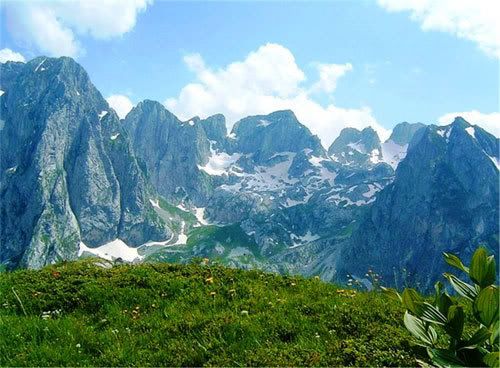
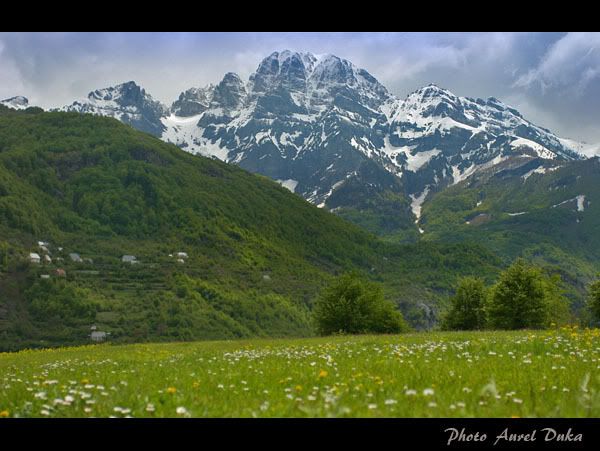
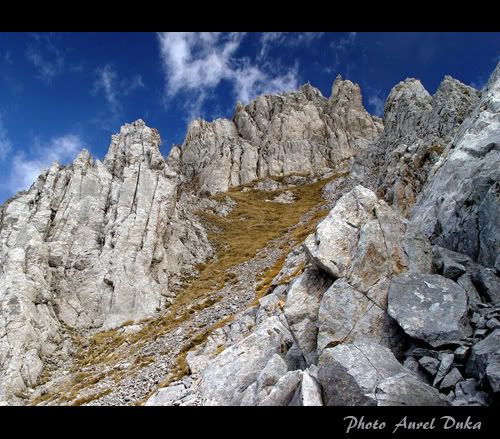
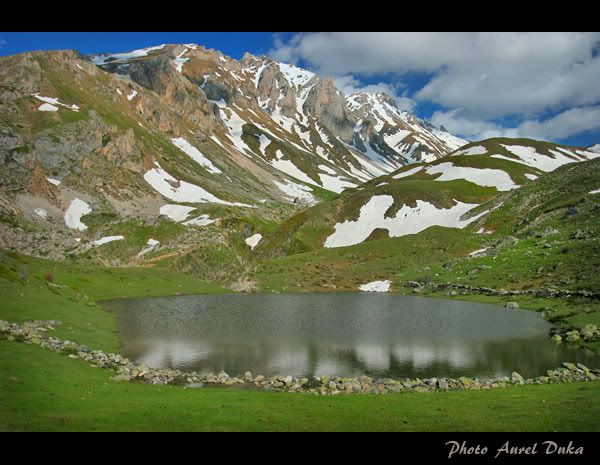
Albania is very rich in biodiversity values.
There are 13 National Parks, 4 Protected Landscape Areas, 4 Strict Nature Reserves, 26 Managed Nature Reserves, 4 Natural Monuments and other protected areas.
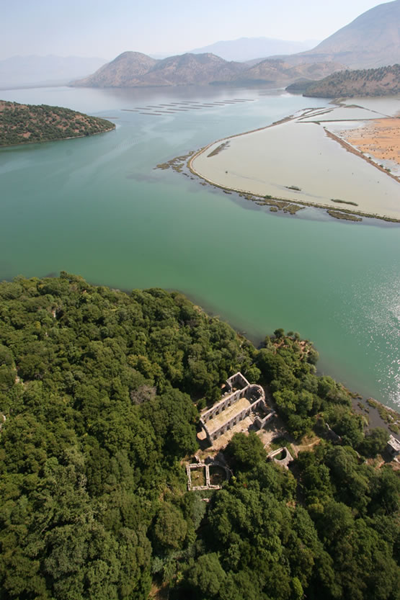
Albania, coastline 450 km, with geographic coordinates: 41N, 20E, with 28.748 km2 (11.100 sq miles), with population of 3.260.000 and density of 113.4 population/km2 is wild and mountainous, with extensive forests, sandy beaches and many beautiful lakes. It shares borders with Montenegro and Kosovo to the north, with the Former Yugoslav Republic of Macedonia to the northeast and Greece to the south. To the west lie the Adriatic and Ionian Seas.
Albania is one of the most mountainous countries in Europe with a rugged mountain terrain which covers 75% of the territory.
The average altitude is 708 m, two times higher than that of Europe.
It's major mountain ranges include the Northern Albanian Alps, Korabi Mountains and Pindus Mountains




Albania is very rich in biodiversity values.
There are 13 National Parks, 4 Protected Landscape Areas, 4 Strict Nature Reserves, 26 Managed Nature Reserves, 4 Natural Monuments and other protected areas.

Subscribe to:
Posts (Atom)

